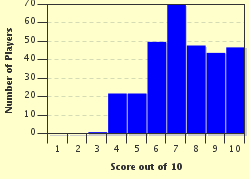Quiz Answer Key and Fun Facts
1. Which of the following battles took place during the American Revolutionary War?
2. Cochise and Geronimo were both leaders of which Native American tribe who fought against the United States at various times between 1849-1886?
3. Which Stalwart Republican president is considered one of America's lesser-known leaders is best known for signing the Pendleton Civil Service Reform Act, which called for government employees to be promoted and hired based on merit and not political status and connections?
4. Though not as famous as nearby Salem, which "A" Massachusetts town also had witch hunts and witch trials in 1692?
5. Which "A" state was important during the Civil Rights Movement of the 1950s and 1960s? It was also the birthplace of many civil rights icons including Rosa Parks, John Lewis and Sammy Younge Jr.
6. Which of following men was a conspirator in the Lincoln assassination and was supposed to kill Andrew Johnson but chickened out?
7. Which of the following was NOT one of Woodrow Wilson's 14 points for peace after World War I?
8. Which of the following laws was passed as part of Franklin Roosevelt's New Deal in 1933?
9. Decided on June 20, 2002, which landmark Supreme Court case stated that the mentally ill could NOT be executed?
10. Signed into law on March 10, 2010, what is one of the proper names of the healthcare law popularly known as Obamacare?
Source: Author
Joepetz
This quiz was reviewed by FunTrivia editor
bloomsby before going online.
Any errors found in FunTrivia content are routinely corrected through our feedback system.


